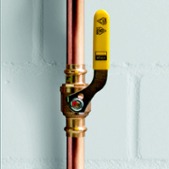Why Pressure Testing Is Important
In the fast-paced, high-demand world of piping, one of the most important steps when installing a system is to pressure test it. In the interest of safety, we must ensure a plumbing system’s integrity before placing it into operation.
And while it’s part of every job, pressure testing plumbing should never be considered routine or an afterthought. Before pressure testing a system (hydrostatic or pneumatic), imagine the worst-case scenario and take the appropriate safety precautions to prevent it.
Learn more about hydrostatic testing in this video.
Dangers of Unpressed Connections
Testing a large piping system with nitrogen could endanger workers if it leaks and displaces oxygen in the air. Compressed air or gases can also burst faulty connections, regardless of the joining method, and turn them into flying shrapnel. The stored energy in 500' of 2" pipe at 150 PSI is equal to eight ounces of TNT — more than enough to cause serious harm.
That’s why it’s important to make sure all workers are out of harm’s way when pressure testing. Warn any other tradespeople working in the area and be sure to protect yourself. Contractors should always wear the appropriate personal protective equipment.
Hydrostatic testing is safer than pneumatic testing because water generates considerably less stored energy but is not without risks. Murphy’s Law dictates that any rupture will empty into the computer server room, not a stairwell. Also, hydrostatic testing isn’t always an option, especially in freezing conditions.
Ace Your Pressure Test with Viega
Avoiding disasters like the above is why Viega invented Smart Connect technology. It makes it easy to detect unpressed fittings during pressure testing. Simply put, Viega press fittings will not hold pressure within a certain range if they are not pressed.
It eliminates the false positives other fittings can yield, masking problems that will surface later. Smart Connect is built into every fitting for the ProPress system, MegaPress system and PureFlow Press Polymer. This patented technology is also engineered into most of our valves.
We recommend conducting initial pneumatic testing at ½ to 45 PSI, monitoring the pressure test gauge and then walking the job to check for unpressed fittings. Our recommendation for initial hydrostatic testing is 15 to 85 PSI water, monitoring the pressure test gauge, followed by walking the job. If you go above 85 PSI, you can push the sealing element into a small indentation on the inside of the fitting, giving a false positive read.
Final pressure testing should be done according to local codes. Once all fittings have been verified as pressed, you can test up to 200 PSI pneumatic or 600 PSI hydrostatic on metallic systems and up to 100 PSI hydrostatic or pneumatic on PEX systems.
Learn more about Smart Connect technology pressure testing in this video.
Easier Pressure Testing for Plumbing
Testing a ProPress fitting system is easier with the Viega ProPress Test Plug. This simple device allows you to pressure test a system without making a press on the final fitting.
Simply insert the plug into the unpressed end of the final fitting and tighten it by hand until it’s fully inserted. Then, attach the test equipment to the included hose bib and perform the pressure test. Once it’s done, drain the system through the hose bib and unscrew the test plug before making the final press on the system.
The test plug is available in ¾" and ½". Best of all, it’s reusable, so it pays for itself quickly.








